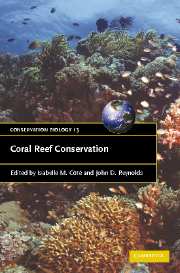Book contents
- Frontmatter
- Contents
- List of contributors
- Foreword
- Preface
- Part I Setting the stage
- Part II Uses and abuses: ecological and socio-economic issues
- 5 Challenges and accomplishments towards sustainable reef fisheries
- 6 Live food and non-food fisheries on coral reefs, and their potential management
- 7 Tourism and coral-reef-based conservation: can they coexist?
- 8 Longer-term impacts of climate change on coral reefs
- Part III The way forward: tools and approache
- Index
- Plate section
- References
5 - Challenges and accomplishments towards sustainable reef fisheries
Published online by Cambridge University Press: 05 June 2012
- Frontmatter
- Contents
- List of contributors
- Foreword
- Preface
- Part I Setting the stage
- Part II Uses and abuses: ecological and socio-economic issues
- 5 Challenges and accomplishments towards sustainable reef fisheries
- 6 Live food and non-food fisheries on coral reefs, and their potential management
- 7 Tourism and coral-reef-based conservation: can they coexist?
- 8 Longer-term impacts of climate change on coral reefs
- Part III The way forward: tools and approache
- Index
- Plate section
- References
Summary
INTRODUCTION
Sustainable use is the concept that resources should be used in a way that achieves a balance between resource production and human consumption, such that harvesting will not reduce future production and options for resource use. Sustainable management therefore requires a shift in focus from short- to long-term use and profits, and places importance on sustaining species with potential future uses. It is also closely aligned with ecosystem management concepts where resource use is expected to maintain the many ecological processes and diversity while managing for multiple present and future needs of people. These concepts are generally acceptable and desirable to most members of society but the problem with implementing them is that they can frequently conflict with the daily practices and desires of the individuals that collect resources, which are frequently focused on minimizing effort and maximizing short-term harvests and profits (Aswani, 1998) and therefore lead to ‘collective action problems’ when the resources are being collected by many with the same profit motives (Ostrom, 1990). Further, the continual improvements of technology and increases in human populations have produced harvesting and marketing potential beyond the production potential of most ecosystems. Coral reefs are no exception but because they are often viewed as a ‘common-pool resource’ with exceptionally high biological diversity and potential uses they pose special problems for management.
- Type
- Chapter
- Information
- Coral Reef Conservation , pp. 147 - 182Publisher: Cambridge University PressPrint publication year: 2006
References
- 9
- Cited by



